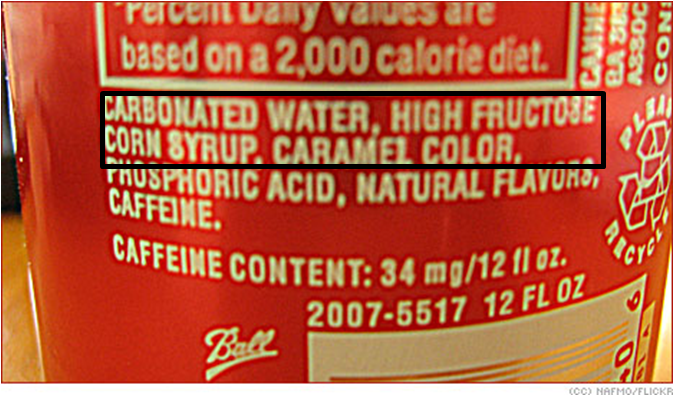What is fructose?
Fructose is a monosaccharide, the simplest form of carbohydrate. As the name implies, mono (one) saccharides (sugar) contain only one sugar group; thus, they can’t be broken down any further.
Each subtype of carbohydrate has different effects in the body depending on the structure and source (i.e. what food it comes from). The chemical structure affects how quickly and/or easily the carbohydrate molecule is digested/absorbed. The source affects whether other nutrients are provided along with the carbohydrate.
For example, both high fructose corn syrup (HFCS) and fruit contain fructose, but their effects in the body are different. HFCS is essentially a simple fructose delivery system – there’s nothing else to it, while fruit contains additional nutrients along with fibre, which affect digestion and absorption of the fructose. Plus, the amount of fructose in the average apple is much less than, say, the average can of soda.
Fructose has a unique texture, sweetness, rate of digestion, and degree of absorption that is different from glucose, which is the sugar that most of our ingested dietary carbohydrates become when they hit the bloodstream.
- Fructose is absorbed through the intestine via different mechanisms than glucose
- Fructose has a slower rate of uptake
- Unlike glucose, fructose does not stimulate a substantial insulin release
- Fructose is transported into cells via a different transporter than glucose
- Once fructose is in the liver, it can provide glycerol, the backbone of fat, and increase fat formation
- Some people may be unable to completely absorb fructose when given in a high dose of around 50 grams (Note: that’s an extremely high amount of fructose. We’re talking 4-5 medium apples. Yet a 16 oz juice with HFCS can provide around 45 grams of fructose)
- Consuming glucose with fructose at the same time accelerates the absorption of fructose. This is one of the reasons that many sports drinks contain a mixture of sugars.
Why is fructose important?
500 years ago, before the mass production of sugar, we had minimal fructose in our diet. Fructose was only provided as part of a whole food. Whole fruits, vegetables, grains, nuts/seeds and proteins have limited amounts of fructose and allowed for a moderate intake. As the food industry refined fructose from sources such as corn, and added it to a variety of processed foods, our fructose consumption increased.
Fructose consumption increased considerably between 1970 and 2000. While most people associate fructose with fruit, most of our daily fructose now comes from non-fruit sources. A survey from the 1990s showed that the average person had a daily added sugar intake of ~80 grams (equivalent to ~320 calories or 15% of energy intake); about half of this was fructose.
We not only get fructose from HFCS, but from sucrose (table sugar). Sucrose is a disaccharide (two sugars) made up of glucose + fructose. HFCS and sucrose are found in processed foods including sweets, soft drinks, and nearly every “edible food-like substance” found in a bag and/or box.

What you should know
Our liver is the major site of fructose metabolism. In the liver, fructose can be converted to glucose derivatives and stored as liver glycogen. The liver can only use and store so much fructose as glycogen at one time. The remainder will be stored as fat; thus, a very high single-serving dose of fructose is much more likely to find a home around your middle. This is more prominent in those individuals with high blood lipids, insulin resistance, or Type 2 diabetes.
A high intake of fructose (unlike other dietary carbohydrates) can fail to stimulate the normal production of leptin. Leptin is a hormone involved in the long-term regulation of energy balance. It goes up when we get enough calories/energy and down when we don’t, to let us know it’s either time to stop or start eating. The decrease in leptin production associated with chronic high fructose intake can have harmful effects on the regulation of food intake and body fat. In other words, with HFCS, you never get those “I’m full” signals from the brain, so you keep eating even though you’ve gotten plenty of calories.
Since fructose stops off in the liver, it elicits a low glycemic response. While this can be a positive attribute when consuming whole fruits, it doesn’t warrant the use of added fructose sweeteners. Although fructose is low on the glycemic scale and can help replenish liver glycogen in the physically active, excess intakes of fructose can lead to the new creation of fats in the liver as well as a short circuiting of our energy balance and body fat regulating systems. As a result, consuming high amounts of high fructose sweeteners can lead to central obesity (weight gain around the middle), low levels of good cholesterol, high levels of bad cholesterol, high triglycerides, and poor appetite control.
Clinical data shows that individuals who consume a diet rich in fruits (and vegetables) tend to get leaner, stay leaner and have better health than those who don’t.
For extra credit
Worried about fruit? Relax. Experts have concluded: “The intake of naturally occurring fructose from an unprocessed, whole food diet is low and unlikely to contribute to any negative metabolic consequences.”
Eating more fruits (and vegetables) can help to prevent chronic disease, including cancers. See here.
Dr. Vioque, an author on a study tracking the fruit consumption of adults over 10 years, feels that people shouldn’t be worried about gaining body fat from over-eating whole fruits: “There is no study showing a significant long-term weight gain by over-eating whole fruit.”
If you’re concerned about health and optimal body composition, go ahead and eat that orange, but think twice about that bottle of orange juice (or worse, the can of orange soda).

Summary and recommendations
When it comes to fructose, source matters. It’s highly unlikely that consuming whole, unprocessed, fresh fruits will promote energy imbalances and body fat gains. However, it’s likely that the regular consumption of fructose-rich fruit juices, sweeteners and energy dense foods will cause these problems. Our bodies have a long-standing and sustainable relationship to fruit that they do not have to fructose and high-fructose sweeteners.
Consuming whole fruits will provide an abundance of nutrients and help control energy intake. It takes over 8 pounds of most fresh fruit to provide 2000 calories. Humans usually don’t eat more than ~5 pounds of food per day.
Avoid purchasing foods/beverages with added fructose sweeteners.
Ask yourself – is my over-consumption of whole fruit leading to nutrition problems, such as chronic disease progression and body fat gains?
References
Click here to view the information sources referenced in this article.
Eat, move, and live… better.©
The health and fitness world can sometimes be a confusing place. But it doesn’t have to be.
Let us help you make sense of it all with this free special report.
In it you’ll learn the best eating, exercise, and lifestyle strategies — unique and personal — for you.




Share